Otago Peninsula
The Otago Peninsula is a long, hilly indented finger of land that forms the easternmost part of Dunedin, New Zealand. Volcanic in origin, it forms one wall of the eroded valley that now forms Otago Harbour. The peninsula lies south-east of Otago Harbour and runs parallel to the mainland for 20 km, with a maximum width of 9 km. It is joined to the mainland at the south-west end by a narrow isthmus about 1.5 km wide.
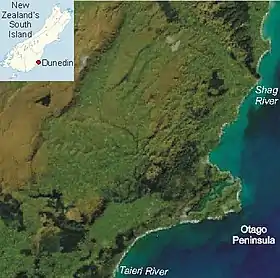
The suburbs of Dunedin encroach onto the western end of the peninsula, and seven townships and communities lie along the harbourside shore. The majority of the land is sparsely populated and occupied by steep open pasture. The peninsula is home to many species of wildlife, notably seabirds, pinnipeds, and penguins, and several ecotourism businesses operate in the area.
Geography
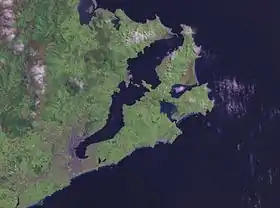

The peninsula was formed at the same time as the hills that face it across the harbour, as part of the large, long-extinct, Dunedin Volcano. Several of the peninsula's peaks, notably the aptly named Harbour Cone, clearly show these volcanic origins in their form. These rocks were built up between 13 and 10 million years ago.
Much of the peninsula is steep hill country, with the highest points being Mount Charles (408m), Highcliff (381m) and Sandymount (320m). Two tidal inlets lie on the Pacific coast of the peninsula, Hoopers Inlet and Papanui Inlet. Between them is the headland of Cape Saunders. Nearby natural features include the 250-m-high cliffs of Lovers' Leap and The Chasm.
At the entrance to the Otago Harbour the peninsula rises to Taiaroa Head, home to a breeding colony of northern royal albatross, the only colony of albatross to be found on an inhabited mainland. The viewing centre for the albatross colony is one of the peninsula's main ecotourism attractions, along with other wildlife such as seals and yellow-eyed penguins. Most of the Otago Peninsula is freehold farming land, with increasing numbers of small holdings or lifestyle blocks. Some biodiversity sites such as Taiaroa Head are managed as sanctuaries for wildlife. Many species of seabirds and waders in particular may be found around the tidal inlets, including spoonbills, plovers, and herons.
The Pacific coast of the peninsula includes several beaches that are far enough removed from Dunedin to be sparsely populated even in mid-summer. These include Allans Beach, Boulder Beach, Victory Beach, and Sandfly Bay.
Victory Beach, named after the 19th century shipwreck of the Victory close to this coast, features a rock formation known locally as "The Pyramids" for its resemblance to the ancient Egyptian monuments. Sandfly Bay, named not for the insect but for the sand blown up by the wind, is reached via a path through some of New Zealand's tallest sand dunes, which rise for some 100 metres above the beach.
Other tourist attractions on the peninsula include Larnach Castle, a restored Armstrong 'disappearing' gun coastal defence post, and a war memorial cairn. There are views of the city and surrounding country from Highcliff Road, which runs along the spine of the peninsula.
The total population of the peninsula is under 10,000, with about half of these in the suburbs of Dunedin that encroach onto its western end, such as Vauxhall and Shiel Hill. For much of its length, only the strip adjacent to the Otago Harbour is populated, with several small communities dotting its length. Largest of these are Macandrew Bay (the peninsula's largest settlement, with a population of 1,100), Portobello, and Otakou, which was the site of the first permanent European settlement on the harbour, and the site of an early whaling station, commemorated at nearby Weller's Rock. There were several other whaling stations inside the harbour and outer peninsula, including the Middle Fishery Station at Harington Point.[1]


History
Pre-European settlement
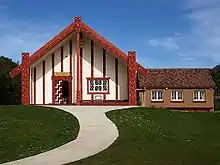
Modern archaeological opinion favours a date for New Zealand's first human settlement around 1300 AD,[2] with people concentrated on the east coast of the South Island. In Archaic (or moa hunter) times the Otago Peninsula was a relatively densely occupied area at the centre of the country's most populous region.
A map of recorded Māori archaeological sites for the Otago Conservancy shows many more on the Otago Peninsula than elsewhere in the region.[3] Another showing only those of the Archaic period shows sites clustered on the peninsula and along the coast across the harbour to the west and north.[4] This was one of three more or less distinct clusters on the South Island's south east coast: one from about Oamaru south to Pleasant River; another from Waikouaiti south, which includes the Otago Peninsula and tails off about the Kaikorai estuary; another extending south from the Clutha mouth. The clusters contain a few larger sites. On the Otago Peninsula the one at Little Papanui is of middle size while that at Harwood Township is one of the largest. These and numerous other smaller sites are clearly visible, though often not recognised by visitors for what they are.
Their occupants were people of Polynesian culture and descent, ancestral to modern Maori, who lived by hunting large birds, notably the now extinct flightless moa, but also seals and by fishing.
Whale ivory chevron pendants found at Little Papanui were made by the site's early occupants and are now in the Otago Museum, Dunedin. The site's lowest levels have been estimated to have been occupied some time between 1150 and 1300 AD. Another peninsula site, at Papanui Inlet, is thought to have been occupied in the same period, as was the extensive one at Harwood Township.[5] Little Papanui and Harwood are considered to have been permanent settlements, not temporary camps. A single radiocarbon date for Harwood suggests it was also occupied in 1450.[6] Three magnificent greenstone adzes, said by H.D. Skinner to be the finest of their type, were found nearby and are dated to the same time. They represent a form already archaic when they were made. They are in the Otago Museum.
Southern Māori oral tradition tells of five successively arriving peoples and while the earliest, Kahui Tipua, appear to be fairy folk, modern anthropological opinion is that nevertheless they represent historical people who have become encrusted with legend.[7][8] Te Rapuwai were next and seemed to be succeeded by two Waitaha tribes, but it has been suggested this was really one with 'Waitaha' also being used as a catchall name for all earlier peoples by some later arrivals. 'Te Rapuwai' may perhaps also have been used like this.[7] Nevertheless, some middens, such as those on the peninsula, have been identified traditionally with Te Rapuwai. Anderson's later, or tribal Waitaha, arrived in the south in the 15th century.
Moa and moa hunters went into decline but a new Classic Māori culture evolved, characterised by the construction of pa, fortified villages, and new peoples arrived on the Otago Peninsula. People here at this time practised what has been called a foraging economy. Increasing reliance seems to have been placed on harvesting the root of the cabbage tree (cordylline australis) and 'umu ti', cabbage tree ovens, proliferate over some parts of the Peninsula showing intensive use of the land.
Kati Mamoe (Ngāti Mamoe in modern standard Māori) arrived in the late 16th century. Kai Tahu (Ngāi Tahu in modern standard Māori) came about a hundred years later. Pukekura, a fortress on Taiaroa Head, was built about 1650. Nearby villages on Te Rauone Beach perhaps date from the same time. Pukekura's terraces are still visible, with some of them co-opted into later European defence works.
Many traditions survive from this period concerning figures such as Waitai and Moki II who at different times both lived at Pukekura pa. One of the best known concerns Tarewai who is difficult to place chronologically but was of Kai Tahu descent. He gained possession of Pukekura, was in conflict with Kati Mamoe at Papanui Inlet and made a famous escape back into Pukekura by a cliff still known as Tarewai's Leap. There had been an argument about Kati Mamoe fishing rights on Papanui Inlet. A particularly fine, talismanic, whale bone fishook of the 18th century was found there and is now in the Otago Museum.
Arrival of the Europeans
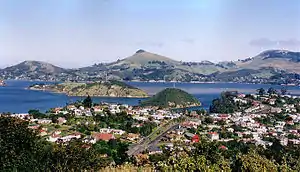
James Cook was off the coast in February 1770 and named Cape Saunders after the Secretary of the Admiralty. His chart showed a bay at what is Hooper's Inlet, which may have been explored and named by Charles Hooper chief officer on Daniel Cooper's English sealer, Unity, in the summer of 1808–1809. Sealers used the harbour from about this time, probably anchoring off Wellers' Rock, modern Otakou, where there was an extensive Māori settlement or settlements. The Sealers' War (also known as the War of the Shirt) was sparked by an incident on the Sydney Cove in Otago Harbour late in 1810 while her men were sealing at Cape Saunders. This incidentally produced James Kelly's attack on 'the City of Otago', probably the Te Rauone settlement(s) in December 1817 after William Tucker and others had been killed at Whareakeake (Murdering Beach) a few miles north. Peace was re-established by 1823. 1826 saw the visit of the Rosanna and the Lambton, ships of the first New Zealand Company bringing the first recorded European women and producing Thomas Shepherd's pictures of the Peninsula, the oldest now known, held in the Mitchell Library Sydney. In November 1831 the Weller brothers, Joseph, George and Edward, established their whaling station at Wellers Rock.
In the course of a turbulent decade the Wellers' Otago establishment grew to be the largest in the country and the harbour became an international whaling port. European women were present at the station from the beginning. There was conflict with Māori who suffered epidemics of measles and influenza in 1835 and 1836. Whaling collapsed in 1839 and Dumont D'Urville, a visiting French navigator, described the Peninsula's European and Māori communities both trafficking in alcohol and sex, in March 1840. The Treaty of Waitangi was signed on the Peninsula in June, although the South Island had already been annexed by 'right of discovery'. The first Christian service was preached on the Peninsula later that year at Otago by Bishop Pompallier. In 1841 Octavius Harwood and C.W. Schultze took over the Wellers' operation.
Various European visitors in the 1840s made records.
During the negotiations for the sale of the Otago Block by the local Ngāi Tahu in 1844 to the Otago Association for its Scottish Free Church settlement, the Ngāi Tahu leaders at the initial meeting with the New Zealand Company, who were the association's agents on 18 June stated their wish to retain the entire peninsula for themselves. However the company's surveyor Frederick Tuckett [was reluctant to allow the Ngāi Tahu to retain military strategic land so close to the proposed site of the new settlement nor allow them to control land on which there were already European settlers in case they developed a settlement that would compete with that of the Otago Association's. The Ngāi Tahu negotiators convinced Turkett that while they would give up some of the peninsula they would be retaining the northern portion, as this was where their villages and urupa were though there were some chiefs with strong Mamoe connections who wanted to retain all of the Peninsula from Puketai onwards (as Andersons Bay was then called). When William Wakefield of the New Zealand Company arrived on site on 16 July he was reluctant to accept this. Eventually however if he wished to proceed with the purchase of any land Wakefield had to accept the Ngāi Tahu position. The deed of sale was signed on 31 July 1844 with the Ngāi Tahu retaining 6,665 acres (2,697 ha) of the northern part of the peninsula.[9]
Charles Kettle, the association's surveyor, laid out suburban and country blocks in 1846 and 1847. The arrival of the first migrant ships in early 1848 saw the focus of settlement move to Dunedin while Port Chalmers on the other side of the harbour succeeded Otago as the international port. In December William Cargill, secular leader of the Otago settlement, successfully petitioned the government to re-instate 'Otago' as its original name. The old whaling village and adjacent Māori settlements had now become 'Otakou'.[10]
Growth of modern settlement
As Dunedin developed the Peninsula's southern end became a city recreation ground and then a suburb. As increasing numbers of immigrants began arriving settlements were formed on the harbourside and on the Highcliff Road on the spine of the land mass, but in the early phase of European settlement, also on the more exposed Pacific slopes.
The discovery of gold in 1861 resulted int a massive inrush of people and capital into Otago. Over the next decade millions of pounds worth of gold flowed from the diggings, the majority passing through Dunedin. The rapid growth of Dunedin into the most prosperous city in New Zealand stimulated development on the peninsula as farmers received higher prices for many of the goods that they supplied the city. By 1864 the population of the peninsula had grown to 1,269 and to 2,425 by 1881.[9] The Maori population living on the peninsula however had decreased from a minimum of 500 to 600 in the early 1830s and to 22 in 1891.[9] As a result of increased settlement native bush was cleared over most of the terrain in a massive transformation of the landscape.
The increased wealth also lead in the 1860s to pleasure gardens being established at Vauxhall; George Grey Russell built his house at Glenfalloch and William Larnach acquired the land for his big house at Pukehiki, 'Larnach Castle'.[11]
A lighthouse was built at Taiaroa Head in 1864 and work began using prison labour, to build the winding harbourside road, with its distinctive seawalls of the local stone. Across the cleared land settlers built dry stone walls, following the pattern of 'Galloway Dykes', another conspicuous and distinctive feature of the landscape whose only other examples in New Zealand are across the harbour on the opposite heights. Stone lime kilns were built near Sandymount in 1864.
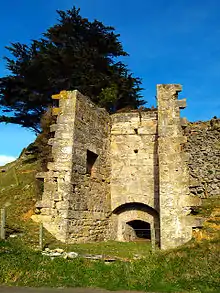
By the end of the 1860s most farms were less than 100 acres (40 ha) in size, with a total of 6,00 acres (2,428 ha) fenced off and growing either crops or livestock. By 1880 about a third of the land area of the peninsula was being farmed (moistly in the form of dairying), with the rest still in bush, swamp or sand.[9] From the times of the earliest European settlements with the harbour surrounded by bush covered hills and no roads existing other than simple bridal tracks using the waters of the harbour offered the most efficient means of transporting passengers and goods between settlements. As settlements developed jetties were constructed at Andersons Bay, Vauxhall, Waverly, Burns Point, Johnstons, Glenfallach, Macandrew Bay, Company Bay, Broad Bay, Ross Point, Portobello, Otakou and Harington Point.[9] In 1862 a jetty was constructed at Andersons Bay to service Vauxhall Gardens, a large entertainment venue with gardens, baths, hotel, sports grounds, swings and roundabouts and a band rotunda. The jetty was used by a number of ferries including the Nugget, Lady of the Lake (in 1864 and 1865), Golden Age (over the summer) Minerva (briefly in 1864) and the Iron Age to being customers to the venue until following the end of the gold rush the venture became uneconomic and eventually closed.[9] Roads boards were responsible for the construction of new roads and their maintenance. A road to Andersons Bay and Tomahawk was completed by the winter of 1860, and from there to Highcliff and Portobello was by bridle track which was not suitable for wheeled transport, which lead to most settlements being restricted to Andersons Bay, Tomahawk, Portobello and smaller settlements along the coast where they could be serviced by ferries.[9] Ferry services first began in 1859.
A railway was completed to Andersons Bay in 1878 but it never proceeded any further. A causeway was completed across Andersons Bay to Vauxhall Corner in 1872. It featured a bridge which could be opened to allow passage for boats.
Following the abolishing of the provincial council in 1876, governance of the peninsula became the responsibility of the Peninsula County Council, whose administrative centre was in Portobello.
By 1878 the bay road had reached Portobello which allowed a mail coach and later horse-drawn buses to operate along it while many residents made their way independently by their own private horses and carts. The resulting drop in patronage lead to many ferry services being withdrawn. The improved land connection encouraged the development of settlements at East Harbour (subsequently renamed Macandrew Bay), Company Bay and Broad Bay.
In the 1880s, following fears of a Russian invasion, Taiaroa Head was extensively fortified. An Armstrong Disappearing gun was installed in 1886. Ferries linked the peninsula's harbour coast with the city and Port Chalmers.
Despite the erosion-prone clay soils and steep slopes by 1900 90% of the approximately 200 farmers on the peninsula were engaged in dairying. This led to New Zealand's first dairy co-operative, being established at Springfield on the Highcliff Road in 1871. Once the Taieri and Peninsula Milk Supply Company was established in 1884 most dairy farmers became members through for a brief period in the late 1880s milk was shipped across the harbour from Portobello for processing at Sawyers Bay at by Roseville Dairy Company. Between 1891 and 1896 farmers also had the option of supplying the New Zealand Dairy Supply Company which also operated in the area. The Taieri and Peninsula Milk Supply Company opened a creamery at Sandymount in 1893 and by 1897 there were additional ones at Granton, Papanui Inlet and Otakou. Another opened at Highcliff in 1903. The resulting product was shipped to Dunedin where it was made into butter.[9] By this time the peninsula was also supplying the majority of Dunedin's potatoes with approximately 70 farmers around Highcliff and Sandymount engaged in their production. In addition there were a number of Chinese dominated market gardens at Andersons Bay and a smaller number at Portobello (from 1881 onwards) growing a wide range of produce.[9] The first telephone was installed in Andersons Bay in 1885.
Land clearance continued at pace and by 1915 only 938 acres (379 ha) of bush remained.[9] In 1888 a universally unpopular toll on the low road to Portobello was introduced by the Portobello Road Board to offset its maintenance and development costs.[12] the toll gate was located near Macandrew Bay. During the 1890s the Portobello Road became popular with cyclists who lobbied the Road Board to reduce the toll. Cyclists were being charged 5 shillings for the round trip, which had been reduced by 1896 to sixpence on Sundays and reduced further to 1903 to sixpence return and then to threepence in 1904. In 1908 the toll was removed.[12] In 1907 the first automobile was sighted on the road but a bylaw was introduced to ban them until a local referendum was held in 1913 overturned it. These actions improved accessibility and reduced the cost of accessing the peninsula, which impacted on the ferries.
By 1900 of the peninsula's 24,016 acres (9,718 ha) only approximately 4,000 acres (of which 3,000 was still in bush) had not been occupied by farming activities or urban construction. By that same year Andersons Bay was becoming a popular place to live, especially with businessman and professionals, a number of them constructing large homes.
In 1904 a marine fish hatchery was established at Aquarium Point, Portobello. Another sign of changing attitudes to wild life was the self-establishment of the royal albatross colony at Taiaroa Head in the 1920s which was now carefully nurtured for its scientific interest.
Radio masts appeared at Highcliff and rural depopulation was compensated by the growth of the harbourside settlements. Improving roads saw the demise of the ferries.
After World War 2 the Taiaroa Head garrison was withdrawn and the lighthouse automated. The University of Otago took over the hatchery as a research facility as its commercial purpose waned.
The 20th century saw land use change as the draining and development of the Taieri Plain eventually led to that area eclipsing the Peninsula's dairying and mixed farms gave way to extensive grazing. The rural population, especially on the Pacific coast, dwindled, leaving abandoned steadings and roads decaying slowly behind macrocarpa and hawthorn plantings. The re-made, Europeanised landscape now took on an air of mellow decay, and started to look 'natural', unusual in a recently colonised country like New Zealand. This attracted the attention of visitors and artists. Colin McCahon, New Zealand's most celebrated painter, first worked out his 'vision' of the New Zealand landscape with studies of the peninsula, the most developed being that of 1946-49 now owned by the city and on display in the central Dunedin Public Library.
The City of Dunedin absorbed Peninsula County in 1967, promising to extend water and sewerage reticulation.
In recent decades there has been growing suburban occupation of the townships, some 'lifestyle' developments on the harbour slopes and an increasing tourist traffic.
The Otago Peninsula is one of the few places in New Zealand where there is everywhere visible evidence of the long human occupation of the land. In a magnificent but compact setting the challenge is to maintain its balance of human and natural in the face of growing residential and tourist development.
Natural history

Various species of endemic, rare, and endangered wildlife have been confirmed in the vicinity of Otago Peninsula both on land and at sea. Jewelled geckos are known from the area. Giant moas were historically seen on the peninsula.[13] Endangered ocean megafauna such as basking sharks, great white sharks,[14] and leatherback turtles[15] have been confirmed along Otago coasts.
Oceanic birds
There is a diversity of flora and fauna on the Otago Peninsula. Avifauna observed include the endangered yellow-eyed penguin, Megadyptes antipodes,[16] little blue penguin, shags, and the northern royal albatross. For albatross, Taiaroa Head has been colonised, this being the only location in the world close to large-scale human cultivation and habitation. Various species of wading birds also inhabit the peninsula, notably royal spoonbills, which are a common sight around Hooper's Inlet and Papanui Inlet on the peninsula's Pacific coast.
Marine mammals
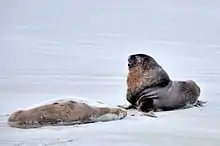
Otago Peninsula's coasts are prominent habitats for marine mammals. Seal and sea lion colonies have regenerated during the 20th century after massive exploitation in the 19th century which almost wiped out both them and whales. A number of New Zealand fur seals and Hooker's sea lions currently breed around Taiaroa Head. Otago Peninsula is considered a remarkable and pioneering habitat, especially for sea lions, as it is the only continual breeding ground on a main inhabited island.[17][18] Southern elephant seals[19] and leopard seals[20] are also known to occur in the area.
Otago Peninsula is regarded as one of the most favoured of habitats for southern right whales on mainland coasts, both currently and historically.[21][22] They were seen frequently in the harbor to breed or calve until the arrival of Europeans. They were the primary target species for shore-whaling and was the major cause for Port Otago to be opened. Whales were hunted almost to extinction, and now are seen rarely. They currently appear ossasionally in the harbor. It is thought that an increase of shipping lanes and accompanying underwater noises may help to keep them away.[23] Future studies might be conducted to examine solutions to bring them back into the harbor.[23][24] On occasions, they can be seen off the coast close to shore in their winter-migration season, along with humpback whales,[25] which were also hunted in the area. Today, quantities of occurrence between these species have become reversed due to drastic difference in biomasses. Taiaroa Head could be the spot with highest possibilities to catch glimpses of these giants. Other Baleen whales that have been confirmed in the area in recent times include blue whales[26] and minke whales.[27][28]
Several species of dolphins and small whales also occur constantly around the peninsula; dusky dolphins[29] and endangered endemic Hector's dolphins form strong connections with the area while bottlenose dolphins and common dolphins appears less frequently. The outer peninsula just off Taiaroa Head is one of three main congregating areas for dusky dolphins in New Zealand[30] while the harbour water and the peninsula provides breeding areas and nurseries,[31] and Hector's dolphins frequent the vicinity of the harbour. Orca are also occasionally seen.[32]
Many other oceanic species such as sperm whales, pilot whales, and several species of beaked whales including the first sightings of Shepherd's beaked whales within the nation and dolphins such as southern right whale dolphins can be found further offshore around the rich, deep sea canyon about 20 km off the peninsula coast which maybe as significant as Kaikoura[33] and rarely strand.[34]
Tourist attractions
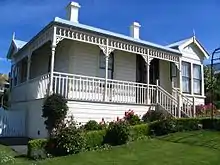
- Fletcher House, an Edwardian cottage museum, Broad Bay.
- Otago Peninsula Museum & Historical Society Museum, Peninsula social and agricultural history, Portobello.
- Glenfalloch Woodland Gardens & Cafe
- Larnach Castle
- Royal Albatross Colony - only mainland colony of albatross in the world
- In 2008 the Dunedin City Council purchased 328 hectares of land surrounding Harbour Cone, a distinctive geological feature on the Otago Peninsula. There are a number of walks to enjoy in this spectacular area, and more information can be found on the Dunedin City Council's website: Harbour Cone
Notes
| Wikimedia Commons has media related to Otago Peninsula. |
- "Whaling Station Locations" (PDF). Shore Whalers Wahine. Retrieved 10 May 2020.
- (Kinaston et al., 2013)
- (Hamel 2001) fig. 1
- (Hamel 2001) fig. 2
- (Anderson 1983, p. 7)
- (Entwisle 1976, p. 8)
- (Anderson 1993, p. 7)
- (Anderson 1998, p. 13)
- West, Jonathan (2017). The Face of Nature: An Environmental History of Otago Peninsula (paperback). Dunedin, NZ: Otago University Press. pp. 134, 152, 154, 155, 186, 188, 192–195, 212, 254, 255, 262–263, 266, 268, 331. ISBN 978-1-927322-38-3.
- (Entwisle 1998, p. 137)
- (Knight 1978, p. 51 & 53)
- McAvinue, Shawn (16 February 2020), "Road once took its toll on travellers", Otago Daily Times, retrieved 10 June 2020
- Buick L.T. (1937). "The Moa-Hunters of New Zealand: Sportsman of the Stone Age - Chapter I. Did the Maori Know the Moa?". Victoria University of Wellington Catalogue - New Zealand Texts Collection. W & T Avery Ltd. Retrieved 3 February 2015.
- "Woodside Energy (New Zealand 55794) Limited - Toroa 3D Marine Seismic Survey - Marine Mammal Impact Assessment" (PDF). Report 1'26 Mam 00002-R0. New Zealand Offshore Services, Department of Conservation. 2014. Retrieved 16 January 2015.
- "Review of Seismic Guidelines and Reference Document - Summary of Submissions Received on the Review Discussion Paper". Document Ref No.: BPM-10-DOC-SP-v1.0. Department of Conservation. 2010. Archived from the original on 8 February 2013. Retrieved 16 January 2015.
- (C. Michael Hogan 2009 p.1)
- "Whakahao (male) or Kaki (female) – New Zealand sea lion – Phocarctos hookeri". The New Zealand Sea Lion Trust. Archived from the original on 5 February 2013. Retrieved 25 April 2013.
- Lalas, Chris (1 November 2008). "Recolonization of Otago, southern New Zealand by fur seals and sea lions: unexpected patterns and consequences" (PDF). The University of Waikato. Archived from the original (PDF) on 22 February 2014. Retrieved 25 April 2013.
- "Elephant seal on Otago Peninsula". Cackle TV Productions. Archived from the original on 3 March 2014. Retrieved 25 April 2013.
- Fox, Rebecca (18 August 2009). "Leopard seals bask in balmy conditions". Otago Daily Times. Retrieved 25 April 2013.
- Fox, Rebecca (7 April 2013). "Otago 'hot spot' for whale sightings". Otago Daily Times. Retrieved 25 April 2013.
- "Otago Peninsula named one of the three "hotspots" for Whale Sightings". Monarch Wildlife Cruise - News. Archived from the original on 12 August 2013. Retrieved 23 November 2013.
- Webster, Trudi (2014). "Southern Right Whales (Eubalaena australis): Acoustic Behaviour and Ambient Noise" (PDF). Dunedin: University of Otago. Retrieved 10 May 2020. Cite journal requires
|journal=(help) - "Research - Acoustics". New Zealand Whale and Dolphin Trust. Archived from the original on 5 May 2014. Retrieved 25 February 2014.
- Benson, Nigel (29 April 2009). "Beholding bounty, beauty and a beast". Otago Daily Times. Retrieved 1 November 2011.
- Dungey, Kim (21 July 2012). "Brothers air concerns about Otago Harbour". Otago Daily Times. Retrieved 25 April 2013.
- Rudd, Allison (20 October 2008). "Dwarf minke pays a surprise visit". Otago Daily Times. Retrieved 1 November 2011.
- Gaskin, D.e. (1968). "The New Zealand Cetacea(pdf), Fisheries Research Bulletin No.1(New Series)". New Zealand Marine Department. p. 24.
- Hawke, J.D. (1989). "Dusky Dolphins Lagenorhynchus Obscurus on the Continental Shelf Near Otago Peninsula, South-East New Zealand" (PDF). Dunedin: Chemistry Department, University of Otago. Retrieved 16 December 2014. Cite journal requires
|journal=(help) - Lineage – Scientific Methodology - Annual distribution of Dusky dolphin. Retrieved on 16 December. 2014
- Würsig, B.; Duprey, N; Weir, J. "Dusky dolphins (Lagenorhynchus obscurus) in New Zealand waters - Present knowledge and research goals" (PDF). Texas A&M University, Department of Conservation. Retrieved 16 December 2014. Cite journal requires
|journal=(help) - "Big jump in Orca sightings near harbour mouth". Otago Daily Times. 8 April 2009. Retrieved 25 April 2013.
- Elder V.. 2017. Population of whales off Dunedin coast significant, study finds. The Otago Daily Times. Retrieved on 15 May 2017
- Gibb J.. 2016. Sighting of beaked whale a first. Otago Daily Times
References
- Anderson, Atholl (1983), When All the Moa-Ovens Grew Cold: nine centuries of changing fortune for the southern Maori, Dunedin, NZ: Otago Heritage Books
- Anderson, Atholl; Allingham, Brian; Smith, Ian W G (1996), Shag River Mouth: the archaeology of an early southern Maori village, Canberra, Australia: Australian National University, OCLC 34751263
- Anderson, Atholl (1998), The Welcome of Strangers: an ethnohistory of southern Maori A.D. 1650-1850, Dunedin, NZ: University of Otago Press with Dunedin City Council, ISBN 1-877133-41-8
- Dann, Christine; Peat, Neville (1989), Dunedin, North and South Otago, Wellington: GP Books, ISBN 0-477-01438-0
- Entwisle, Peter (1976), The Otago Peninsula, Dunedin: John McIndoe, ISBN 0-908565-23-2
- Entwisle, Peter (1998), Behold the Moon, the European Occupation of the Dunedin District 1770-1848, Dunedin, NZ: Port Daniel Press, ISBN 0-473-05591-0
- Hamel, J (2001), The Archaeology of Otago, Wellington, NZ: Department of Conservation, ISBN 0-478-22016-2
- Hogan, C. Michael (2009), N. Stromberg (ed.), Yellow-eyed Penguin: Megadyptes antipodes, GlobalTwitcher.com, archived from the original on 5 October 2011
- Kinaston, L. Rebecca; Walter, K. Richard; Jacomb, Chris; Brooks, Emma; Tayles, Nancy (2013), "The First New Zealanders: Patterns of Diet and Mobility Revealed through Isotope Analysis", PLOS One, PLoS One 8(5), e64580, 8 (5): e64580, Bibcode:2013PLoSO...864580K, doi:10.1371/journal.pone.0064580, PMC 3654917, PMID 23691250
- Knight, Hardwicke (1978), Otago Peninsula: a local history, Broad Bay, NZ: Hardwicke Knight
- Sorrell, Paul; Warman, Graham (2013), Peninsula: Exploring the Otago Peninsula, Auckland, NZ: Penguin, ISBN 9780143568537
- West, Jonathan (2017), The Face of Nature: An Environmental History of Otago Peninsula, Dunedin, NZ: Otago University Press, ISBN 978-1-927322-38-3